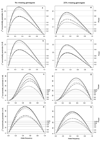A hybrid design: case-parent triads supplemented by control-mother dyads
- PMID: 18759250
- PMCID: PMC2819841
- DOI: 10.1002/gepi.20365
A hybrid design: case-parent triads supplemented by control-mother dyads
Abstract
Hybrid designs arose from an effort to combine the benefits of family-based and population-based study designs. A recently proposed hybrid approach augments case-parent triads with population-based control-parent triads, genotyping everyone except the control offspring. Including parents of controls substantially improves statistical efficiency for testing and estimating both offspring and maternal genetic relative risk parameters relative to using case-parent triads alone. Moreover, it allows testing of required assumptions. Nevertheless, control fathers can be hard to recruit, whereas control offspring and their mothers may be readily available. Consequently, we propose an alternative hybrid design where offspring-mother pairs, instead of parents, serve as population-based controls. We compare the power of our proposed method with several competitors and show that it performs well in various scenarios, though it is slightly less powerful than the hybrid design that uses control parents. We describe approaches for checking whether population stratification will bias inferences that use controls and whether the mating-symmetry assumption holds. Surprisingly, if mating symmetry is violated, even though mating-type parameters cannot be directly estimated using control-mother dyads alone, and maternal effects cannot be estimated using case-parent triads alone, combining both sources of data allows estimation of all the parameters. This hybrid design can also be used to study environmental influences on disease risk and gene-by-environment interactions.
Figures

Similar articles
-
Investigation of maternal effects, maternal-fetal interactions and parent-of-origin effects (imprinting), using mothers and their offspring.Genet Epidemiol. 2011 Jan;35(1):19-45. doi: 10.1002/gepi.20547. Genet Epidemiol. 2011. PMID: 21181895 Free PMC article.
-
Disentangling pooled triad genotypes for association studies.Ann Hum Genet. 2014 Sep;78(5):345-56. doi: 10.1111/ahg.12073. Epub 2014 Jun 24. Ann Hum Genet. 2014. PMID: 24962618 Free PMC article.
-
Benchmarking statistical methods for analyzing parent-child dyads in genetic association studies.Genet Epidemiol. 2022 Jul;46(5-6):266-284. doi: 10.1002/gepi.22453. Epub 2022 Apr 22. Genet Epidemiol. 2022. PMID: 35451532 Free PMC article. Review.
-
A hybrid design for studying genetic influences on risk of diseases with onset early in life.Am J Hum Genet. 2005 Oct;77(4):627-36. doi: 10.1086/496900. Epub 2005 Aug 31. Am J Hum Genet. 2005. PMID: 16175508 Free PMC article.
-
Less is more, except when less is less: Studying joint effects.Genomics. 2009 Jan;93(1):10-2. doi: 10.1016/j.ygeno.2008.06.002. Epub 2008 Jul 21. Genomics. 2009. PMID: 18598750 Free PMC article. Review.
Cited by
-
Investigation of maternal effects, maternal-fetal interactions and parent-of-origin effects (imprinting), using mothers and their offspring.Genet Epidemiol. 2011 Jan;35(1):19-45. doi: 10.1002/gepi.20547. Genet Epidemiol. 2011. PMID: 21181895 Free PMC article.
-
Application of a novel hybrid study design to explore gene-environment interactions in orofacial clefts.Ann Hum Genet. 2012 May;76(3):221-36. doi: 10.1111/j.1469-1809.2012.00707.x. Ann Hum Genet. 2012. PMID: 22497478 Free PMC article.
-
Exploration and comparison of methods for combining population- and family-based genetic association using the Genetic Analysis Workshop 17 mini-exome.BMC Proc. 2011 Nov 29;5 Suppl 9(Suppl 9):S28. doi: 10.1186/1753-6561-5-S9-S28. BMC Proc. 2011. PMID: 22373349 Free PMC article.
-
Association of combined maternal-fetal TNF-alpha gene G308A genotypes with preterm delivery: a gene-gene interaction study.J Biomed Biotechnol. 2010;2010:396184. doi: 10.1155/2010/396184. Epub 2010 Mar 9. J Biomed Biotechnol. 2010. PMID: 20224765 Free PMC article.
-
Candidate gene analysis of spontaneous preterm delivery: new insights from re-analysis of a case-control study using case-parent triads and control-mother dyads.BMC Med Genet. 2011 Dec 30;12:174. doi: 10.1186/1471-2350-12-174. BMC Med Genet. 2011. PMID: 22208904 Free PMC article.
References
-
- Agresti A. Categorical Data Analysis. New York: John Wiley & Sons; 1970.
-
- Dempster AP, Laird NM, Rubin D. Maximum likelihood from incomplete data via the EM algorithm. J Roy Statist Soc B. 1977;39:1–38.
-
- Nagelkerke NJD, Hoebee B, Teunis P, Kimman TG. Combining the transmission disequilibrium test and case-control methodology using generalized logistic regression. Eur J Hum Genet. 2004;12:964–970. - PubMed
-
- Sinsheimer JS, Palmer CGS, Woodward JA. Detecting genotype combinations that increase risk for disease: the maternal-fetal genotype incompatibility test. Genet Epidemiol. 2003;24:1–13. - PubMed
Publication types
MeSH terms
Grants and funding
LinkOut - more resources
Full Text Sources

